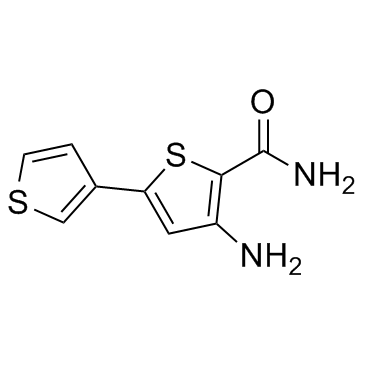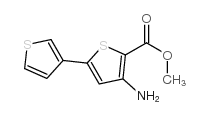354812-17-2
| 中文名 | 4-氨基-[2,3']联噻吩-5-甲酰胺 |
|---|---|
| 英文名 | 3-amino-5-thiophen-3-ylthiophene-2-carboxamide |
| 英文别名 |
4-Amino-2,3'-bithiophene-5-carboxamide
[2,3'-Bithiophene]-5-carboxamide, 4-amino- 4-Amino-[2,3"]bithiophenyl-5-carboxylic acid amide SC-514 IKK-2 Inhibitor GK 01140 |
| 描述 | SC-514 是一种选择性 IKK-2 抑制剂 (IC50=11.2±4.7 μM),不抑制其他 IKK 亚型或其他丝氨酸-苏氨酸和酪氨酸激酶。 |
|---|---|
| 相关类别 | |
| 靶点 |
IKK-2:11.2 μM (IC50) CDK2/A:61 μM (IC50) AUR2:71 μM (IC50) PRAK:75 μM (IC50) MSK:123 μM (IC50) |
| 体外研究 | SC-514抑制天然IKK复合物或重组人IKK-1/IKK-2异二聚体,IC50分别为6.1±2.2μM和2.7±0.7μM。 SC-514对IKK-2的抑制具有选择性,可逆性和ATP竞争性。 SC-514以剂量依赖性方式抑制IL-1β诱导的类风湿性关节炎衍生的滑膜成纤维细胞中NF-κB依赖性基因的转录。 SC-514抑制所有形式的重组人IKK-2,包括rhIKK-2同源二聚体,rhIKK-1/rhIKK-2异二聚体,以及组成型活性形式的rhIKK-2,IC50值在3-12μM范围内相当[ 1]。评估活性氧(ROS)诱导IKKβ抑制剂是否增加黑素瘤细胞对亚硝基脲的敏感性。首先将黑素瘤细胞的反应评估为SC-514/Fotemustine共处理。将黑素瘤细胞系用50μM的SC-514和福莫司汀单独处理并组合处理48小时并评估生长抑制。与SC-514共同处理显着增强了Fotemustine诱导的所有黑素瘤细胞系的细胞毒性[2]。 |
| 体内研究 | SC-514在炎症的急性模型中是有效的,即在大鼠中LPS诱导的血清TNFα产生。 SC-514显示TNFα产生的剂量依赖性抑制,证实IKK-2是体内潜在的抗炎药物靶标[1]。为了获得SC-514在癌细胞对Fotemustine的反应中的暗示的体内证据,使用黑素瘤的异种移植小鼠模型。用载体对照和25mg/kg SC-514和/或25mg/kg Fotemustine每天处理移植有A375或G361肿瘤的裸鼠连续13-15天,并监测肿瘤行为。用SC-514进行福莫司汀治疗显示出明显的联合作用,并减少了小鼠肿瘤的大小[2]。 |
| 激酶实验 | 使用NEMO抗体(3-10μg)从IL-1β处理的RASF细胞裂解物(0.5-2mg)免疫沉淀IKK复合物,然后加入蛋白A-琼脂糖珠。通过离心沉淀抗体复合物,并用1mL冷全细胞裂解缓冲液洗涤3次,然后在激酶缓冲液(25mM HEPES,pH 7.6,2mM MgCl 2,2mM MnCl 2,10mM NaF,5mM DTT)中洗涤2次。和1mM苯甲基磺酰氟)。在含有10μM生物素化的IκBα肽作为底物和1μM[γ-33P] ATP(2500Ci / mmol)的反应中分析100-200μg免疫沉淀的IKK的激酶活性。在室温下孵育30分钟后,取出25μL反应混合物并加入到SAM96生物素捕获板中。在连续洗涤步骤后,使板空气干燥,并向每个孔中加入25μL闪烁液。使用Top-Count NXT [1]测量[γ-33P] ATP的掺入。 |
| 细胞实验 | 对于结晶紫染色测定,将黑素瘤细胞系(1×104)接种在60mm培养皿中,然后未处理或用SC-514(50μM)和/或福莫司汀预处理。然后,将细胞用福尔马林固定并用结晶紫染色。细胞数测量为来自福尔马林固定细胞的溶解的结晶紫在595nm处的光密度(OD595)。细胞毒性也通过MTT还原试验确定[2]。 |
| 动物实验 | 通过口服管饲法(50mg / kg)或腹膜内(10和50mg / kg)给已经被剥夺食物过夜的成年雄性Wistar大鼠施用大鼠[1] SC-514或载体(2%Me2SO的盐水溶液)。 。化合物处理2小时后,在LPS给药后90分钟腹膜内给予盐水中1mg / kg LPS(大肠杆菌);将动物放血并通过大鼠特异性TNFαELISA分析血清TNFα水平。小鼠[2]将雄性nu / nu BALB / c小鼠(6周龄)保持在单独的通风笼中。将A375或G361(5×106)细胞重悬于0.1mL PBS中并皮下接种到裸鼠背部并使其生长7天。之后,将小鼠随机分配到4组(每组n = 6)并通过腹膜内注射200μL30%PEG / 5%吐温-80溶液作为媒介物对照和25mg / kg SC-514和/或或每天25 mg / kg Fotemustine连续13-15天。每3天测量体重和肿瘤体积。通过卡尺确定肿瘤体积并计算。在实验结束时,处死小鼠并收集肿瘤异种移植物。将肿瘤组织储存在-80℃下用于Western印迹分析。 |
| 参考文献 |
| 密度 | 1.5±0.1 g/cm3 |
|---|---|
| 沸点 | 399.2±42.0 °C at 760 mmHg |
| 熔点 | 209-211°C |
| 分子式 | C9H8N2OS2 |
| 分子量 | 224.303 |
| 闪点 | 195.2±27.9 °C |
| 精确质量 | 224.007797 |
| PSA | 125.59000 |
| LogP | 1.52 |
| 外观性状 | white to light brown |
| 蒸汽压 | 0.0±0.9 mmHg at 25°C |
| 折射率 | 1.715 |
| 储存条件 | Store at +4°C |
| 水溶解性 | DMSO: soluble10mg/mL, clear |
|
SECTION 1: Identification of the substance/mixture and of the company/undertaking Product identifiers Product name: SC-514 REACH No.: A registration number is not available for this substance as the substance or its uses are exempted from registration, the annual tonnage does not require a registration or the registration is envisaged for a later registration deadline.
CAS-No.: 354812-17-2 Relevant identified uses of the substance or mixture and uses advised against Identified uses: Laboratory chemicals, Manufacture of substances SECTION 2: Hazards identification Classification of the substance or mixture Classification according to Regulation (EC) No 1272/2008 Acute toxicity, Oral (Category 3), H301 For the full text of the H-Statements mentioned in this Section, see Section 16. Classification according to EU Directives 67/548/EEC or 1999/45/EC T ToxicR25 For the full text of the R-phrases mentioned in this Section, see Section 16. Label elements Labelling according Regulation (EC) No 1272/2008 Pictogram Signal wordDanger Hazard statement(s) H301Toxic if swallowed. Precautionary statement(s) P301 + P310IF SWALLOWED: Immediately call a POISON CENTER or doctor/ physician. Supplemental Hazardnone Statements Other hazards - none SECTION 3: Composition/information on ingredients Substances Synonyms: 4-Amino-[2,3"]bithiophenyl-5-carboxylic acid amide Formula: C9H8N2OS2 Molecular Weight: 224,3 g/mol CAS-No.: 354812-17-2 Hazardous ingredients according to Regulation (EC) No 1272/2008 ComponentClassificationConcentration SC-514 CAS-No.354812-17-2Acute Tox. 3; H301<= 100 % Hazardous ingredients according to Directive 1999/45/EC ComponentClassificationConcentration SC-514 CAS-No.354812-17-2T, R25<= 100 % For the full text of the H-Statements and R-Phrases mentioned in this Section, see Section 16 SECTION 4: First aid measures Description of first aid measures General advice Consult a physician. Show this safety data sheet to the doctor in attendance. If inhaled If breathed in, move person into fresh air. If not breathing, give artificial respiration. Consult a physician. In case of skin contact Wash off with soap and plenty of water. Take victim immediately to hospital. Consult a physician. In case of eye contact Flush eyes with water as a precaution. If swallowed Never give anything by mouth to an unconscious person. Rinse mouth with water. Consult a physician. Most important symptoms and effects, both acute and delayed The most important known symptoms and effects are described in the labelling (see section 2.2) and/or in section 11 Indication of any immediate medical attention and special treatment needed no data available SECTION 5: Firefighting measures Extinguishing media Suitable extinguishing media Use water spray, alcohol-resistant foam, dry chemical or carbon dioxide. Special hazards arising from the substance or mixture Carbon oxides, nitrogen oxides (NOx), Sulphur oxides Advice for firefighters Wear self contained breathing apparatus for fire fighting if necessary. Further information no data available SECTION 6: Accidental release measures Personal precautions, protective equipment and emergency procedures Wear respiratory protection. Avoid dust formation. Avoid breathing vapours, mist or gas. Ensure adequate ventilation. Evacuate personnel to safe areas. Avoid breathing dust. For personal protection see section 8. Environmental precautions Prevent further leakage or spillage if safe to do so. Do not let product enter drains. Methods and materials for containment and cleaning up Pick up and arrange disposal without creating dust. Sweep up and shovel. Keep in suitable, closed containers for disposal. Reference to other sections For disposal see section 13. SECTION 7: Handling and storage Precautions for safe handling Avoid contact with skin and eyes. Avoid formation of dust and aerosols. Provide appropriate exhaust ventilation at places where dust is formed. For precautions see section 2.2. Conditions for safe storage, including any incompatibilities Store in cool place. Keep container tightly closed in a dry and well-ventilated place. Recommended storage temperature: 2 - 8 °C Specific end use(s) A part from the uses mentioned in section 1.2 no other specific uses are stipulated SECTION 8: Exposure controls/personal protection Control parameters Components with workplace control parameters Exposure controls Appropriate engineering controls Avoid contact with skin, eyes and clothing. Wash hands before breaks and immediately after handling the product. Personal protective equipment Eye/face protection Face shield and safety glasses Use equipment for eye protection tested and approved under appropriate government standards such as NIOSH (US) or EN 166(EU). Skin protection Handle with gloves. Gloves must be inspected prior to use. Use proper glove removal technique (without touching glove's outer surface) to avoid skin contact with this product. Dispose of contaminated gloves after use in accordance with applicable laws and good laboratory practices. Wash and dry hands. The selected protective gloves have to satisfy the specifications of EU Directive 89/686/EEC and the standard EN 374 derived from it. Body Protection Complete suit protecting against chemicals, The type of protective equipment must be selected according to the concentration and amount of the dangerous substance at the specific workplace. Respiratory protection Where risk assessment shows air-purifying respirators are appropriate use a full-face particle respirator type N99 (US) or type P2 (EN 143) respirator cartridges as a backup to engineering controls. If the respirator is the sole means of protection, use a full-face supplied air respirator. Use respirators and components tested and approved under appropriate government standards such as NIOSH (US) or CEN (EU). Control of environmental exposure Prevent further leakage or spillage if safe to do so. Do not let product enter drains. SECTION 9: Physical and chemical properties Information on basic physical and chemical properties a) AppearanceForm: solid b) Odourno data available c) Odour Thresholdno data available d) pHno data available e) Melting point/freezingno data available point f) Initial boiling point and no data available boiling range g) Flash pointno data available h) Evapouration rateno data available i) Flammability (solid, gas) no data available j) Upper/lowerno data available flammability or explosive limits k) Vapour pressureno data available l) Vapour densityno data available m) Relative densityno data available n) Water solubilityno data available o) Partition coefficient: n- log Pow: 1,055 octanol/water p) Auto-ignitionno data available temperature q) Decompositionno data available temperature r) Viscosityno data available s) Explosive propertiesno data available t) Oxidizing propertiesno data available Other safety information no data available SECTION 10: Stability and reactivity Reactivity no data available Chemical stability Stable under recommended storage conditions. Possibility of hazardous reactions no data available Conditions to avoid no data available Incompatible materials no data available Hazardous decomposition products In the event of fire: see section 5 SECTION 11: Toxicological information Information on toxicological effects Acute toxicity no data available Skin corrosion/irritation no data available Serious eye damage/eye irritation no data available Respiratory or skin sensitisation no data available Germ cell mutagenicity no data available Carcinogenicity IARC:No component of this product present at levels greater than or equal to 0.1% is identified as probable, possible or confirmed human carcinogen by IARC. Reproductive toxicity no data available Specific target organ toxicity - single exposure no data available Specific target organ toxicity - repeated exposure no data available Aspiration hazard no data available Additional Information RTECS: Not available To the best of our knowledge, the chemical, physical, and toxicological properties have not been thoroughly investigated. SECTION 12: Ecological information Toxicity no data available Persistence and degradability no data available Bioaccumulative potential no data available Mobility in soil no data available Results of PBT and vPvB assessment PBT/vPvB assessment not available as chemical safety assessment not required/not conducted Other adverse effects no data available SECTION 13: Disposal considerations Waste treatment methods Product Offer surplus and non-recyclable solutions to a licensed disposal company. Dissolve or mix the material with a combustible solvent and burn in a chemical incinerator equipped with an afterburner and scrubber. Contaminated packaging Dispose of as unused product. SECTION 14: Transport information UN number ADR/RID: 2811IMDG: 2811IATA: 2811 UN proper shipping name ADR/RID: TOXIC SOLID, ORGANIC, N.O.S. (SC-514) IMDG: TOXIC SOLID, ORGANIC, N.O.S. (SC-514) IATA:Toxic solid, organic, n.o.s. (SC-514) Transport hazard class(es) ADR/RID: 6.1IMDG: 6.1IATA: 6.1 Packaging group ADR/RID: IIIIMDG: IIIIATA: III Environmental hazards ADR/RID: noIMDG Marine pollutant: noIATA: no Special precautions for user no data available SECTION 15 - REGULATORY INFORMATION N/A SECTION 16 - ADDITIONAL INFORMATION N/A |
| 符号 |

GHS06 |
|---|---|
| 信号词 | Danger |
| 危害声明 | H301 |
| 警示性声明 | P301 + P310 |
| 危害码 (欧洲) | T |
| 风险声明 (欧洲) | 25 |
| 安全声明 (欧洲) | 45 |
| 危险品运输编码 | UN 2811 6.1 / PGIII |
| 上游产品 2 | |
|---|---|
| 下游产品 0 | |




![4-amino-[2,3'-bithiophene]-5-carboxylic acid结构式](https://image.chemsrc.com/caspic/312/507472-79-9.png)